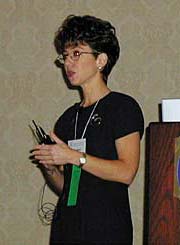Bovine welfare spotlighted at annual forum
|
Lee J. DiVita | ||||
At the AVMA's 11th annual Animal Welfare Forum, Nov 10, 2000 in Itasca, Ill, experts in their respective fields presented attitudes, research, practices, and progressive thought with regard to bovine welfare. The practice of farming as a whole—including raising beef and dairy cattle and veal calves, their housing, handling, transportation, medical care, and breeding—was discussed. Dr. James H. Brandt, AVMA president-elect, welcomed the nearly 200 attendees, expressing the thought that addressing all the issues concerning bovine welfare in a one-day forum was incredibly ambitious, and that many issues could be contentious, such as the welfare of cattle during slaughter, veal calf care, and the ethics of livestock shows and rodeos. Dr. Brandt assured the audience, however, that "veterinarians share a common foundation of love and respect for animals and their welfare. We carefully weigh scientific and ethical viewpoints, presenting persons representing all sides of an issue." The goal of the bovine welfare forum, just as for all previous forums, was to promote the well-being of animals. Director of Livestock, Animal Health and Welfare for the California Farm Bureau Federation AnnMaria de Grassi opened the forum by giving a global overview of the positives and negatives of bovine welfare, and lessons she has learned from her 13 years' experience working for the bureau. "Animal welfare necessarily has to be the most important concern on dairy farms and cattle ranches," de Grassi said. "The American Farm Bureau states, as a matter of its policy, its belief that no segment of society has more concern for the well-being of farm animals, than does the producer." Farmers committed to striving for efficient production ideally work to reduce and eliminate animal stress, illness, and injury. De Grassi quoted upstate New York dairy farmer Judy DiBenedetto, who defined her lifestyle as a "unique blend of people, land, buildings, and animals working together every day. These daily interactions are not only vital to the success of the farm but also tend to create strong ties between the people and everything on their farms." Attitudes of farmers such as di Benedetto exemplify some of the best observed by de Grassi. She has had the privilege of working with several progressive, open-minded farmers, researchers, animal welfare advocates, and regulators around the world. Along with these individuals, there are quality assurance programs, which educate producers on how to meet consumer concerns for animal welfare, as well as produce quality products. She cited the California Cattlemen's Association as working with veterinarians, advisers, and academics, and graduating more than 3,900 producers in such programs since 1993. Current research, animal care practice documents, academic agency resources, and help lines are all tools used to instruct, inform, and educate farmers on generally accepted practices in terms of animal welfare. They can turn to these sources to ensure adequate or improved animal care, address concerns, and review advances in science and viewpoints on their various practices. According to de Grassi, a 1999 survey showed consumers are willing to pay a premium for products labeled as being from "humanely raised" animals. These changing societal values led a California dairy cooperative to seek animal welfare certification by the American Humane Association. While the welfare efforts represent the good side of farming, de Grassi stated that those programs are meaningless if just in place as good intentions, or as educational programs seldom used. "To earn credibility, a program has to have evidence that it works," de Grassi said.
Challenges facing bovine handlers and producers, and practices under high scrutiny include cattle prodding, hot-iron branding, castration, and dehorning. De Grassi addressed them as traditional practices that may need reevaluation and change because of changing societal values. She said the need for applied research to identify more welfare-friendly alternatives to these painful practices is paramount. "These remain welfare topics largely because science technology, economics, and policy have yet to surface universally acceptable alternatives to achieving the goals of those practices," she said. "Science has helped us refine them, but we don't have alternatives to them. We need a broader dialogue between cattle caregivers and allied industries as to what research and audits reveal, to help producers do their job better." The unfavorable side of bovine welfare included the media's portrayal of a few incidents involving cull and downer cattle in Florida and Arizona. The images were broadcast by TV networks and over the Internet. De Grassi reminded the attendees that 83 percent of human learning is based on what we see. The media humiliating the industry into doing the right thing is not a proper way to solve animal welfare problems. "Any incident of inhumane treatment going unresolved is intolerable," de Grassi said. "There is no excuse for these animals being mistreated. The causes of welfare problems are no doubt many, ranging from ignorance to intolerance. The bottom line is, no matter what the cause, we must fix what's wrong and do so without excuse." She added that the industry is made up of capable and expert caregivers, and that they should not wait until something hits the TV news to find out what the priorities should be in terms of addressing animal welfare. De Grassi quoted Peter Bradford, another rancher, who said, "Today's business of raising beef is about so much more than about cattle. It's about grass, water, monitoring, fences, education, meetings and mainly trying to stay ahead of the constant regulatory bureaucracy while meeting your overhead. It is way more than 9 to 5." Clearly, de Grassi advocates that everyone involved in raising and producing cattle must exert influence to promote the humane care of animals, and hold one another accountable for their actions.
| ||||


